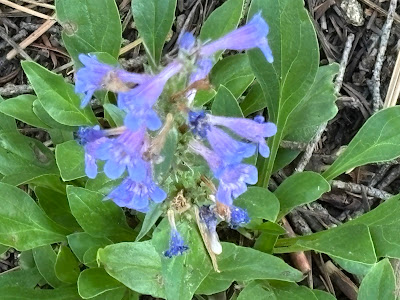 |
| sidebells penstemon, Penstemon secundiflorus |
I was in the general area of Evergreen, Colorado. The path clung to the hillside, under the forest canopy.
 |
| Rocky Mountain forest |
 |
But also alum root (Heuchera, saxifrage family, Saxifragaceae); the cultivated species of Heuchera are called coral bells. This is probably common alum root, Heuchera parviflora. It has no alum (aluminum) in the root, but is astringent enough that it was used in place of alum in dyeing by the early European settlers. (blog on Heuchera)
There were other species in flower, lupines (Lupinus), stoneseed (Lithospermum), wallflowers (Erysimum)...that's why I go on plant walks, for the surprises and the variety.
 |
| alum root, Heuchera |
This is one of the cinquefoils (rose family, Rosaceae). Colorado has at least 35 species that have cinquefoil as a common name. They are closely related to the cinquefoils of Europe, genus Potentilla. Cinque (5) foil (leaf) refers to the five-lobed leaf. The common European cinquefoils do have five-lobed leaves. The American species have three to more than 13 lobes per leaf. Still, the common name carried over. Then, in the last 30 years, the taxonomists looked closely at the cinquefoils and divided up the genus Potentilla into several genera. My Flora of Colorado gives cinquefoil as the common name for plants in the four genera, Potentilla, Argentina, Dasiphora and Drymocallis. I think this is sticky cinquefoil, Drymocallis glandulosa, a handsome flower.
This bright little flower is spearleaf stonecrop (Sedum lanceolatum, stonecrop family, Crassulaceae). I was surprised to see it still in bloom, because, where I live at the base of the mountains, it was done flowering early in June. But that is one of the joys of hiking in the mountains, depending on the microclimate where a plant is growing, it may bloom earlier or later. Of course, higher elevations warm later, so onset of flowering is later, but within that, there is a lot of variation. Stonecrops are succulents; notice the small fat round leaves below the flower stalk?
 |
| spearleaf stonecrop, Sedum lanceolatum |
This small plant with white flowers is a bedstraw, probably northern bedstraw (Gallium boreale, madder family, Rubiaceae). The European species of Galium were used in stuffing mattresses, hence the name bedstraw.
 |
| northern bedstraw, Galium boreale |
These are seed heads, not flowers. This is pussy-toes, Antennaria (sunflower family, Asteraceae). You can see how it gets the name pussy-toes. Colorado has 13 species of Antennaria. Most species are relatively common and occur in the mountains from one end of the state to the other. I do not know which species this is.
 |
| pussy-toes, Antennaria |
These flowers are the kind of cute little "daisies" one walks by without noticing, unless you are on a wildflower hike.The flower heads were tiny, about the size of a dime; my photo is close up enough for them to look like ox-eye daisies (Leucanthemum vulgare), but they are much smaller. I think they are prairie fleabane (Erigeron strigosus), which, despite prairie in the name, can be found nearly to 8000' in the Rockies.
 |
| prairie fleabane, Erigeron strigosus |
Not a giant toad, but I keep seeing it that way:
Plant identification:
Ackerfield, J. 2022. Flora of Colorado, 2nd edition. Denver Botanic Gardens, Denver, CO.
Colorado has a diverse flora, with more than 3,000 species. Many common genera, Penstemon and Potentilla, for example, have dozens of quite similar species. To get flowers to species requires looking carefully at hairs and other small characters; just snapping one photo is rarely enough. The online identification aps can be helpful, but their suggestions for some of these plants were totally wrong. Identifying wildflowers to species remains a challenge.
A Wandering Botanist
More at awanderingbotanist.com
Join me on Facebook: https://www.facebook.com/AWanderingBotanist



No comments:
Post a Comment